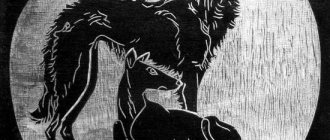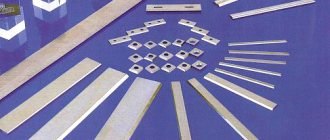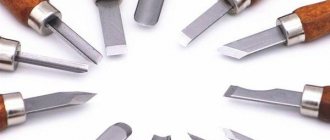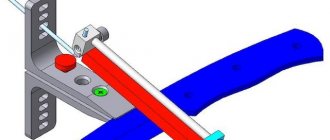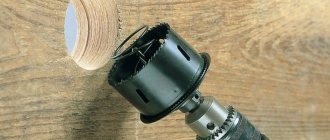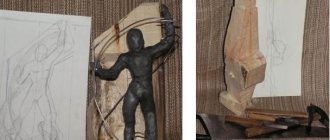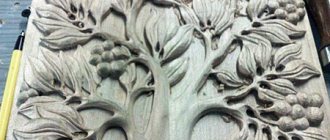All photos from the article
Experienced craftsmen can use even the simplest folding knives with a wooden handle to make various decorative crafts. However, a beginner should use a specialized tool for carving that will allow him to perform all basic operations without additional effort.
In our article we will tell you which knives can be used to process wood, and also provide recommendations for making and sharpening such tools yourself.
With the help of the simplest blade you can create real masterpieces
What a beginner carver can't do without
Anyone who is lucky enough to be in the workshop of a real master of wood carving will be horrified - he uses so many different tools. My eyes just widen. The master will easily determine how to perform this or that stroke, what is best suited for this or that detail. Choosing the right carving tool largely determines the quality of the product.
A novice carver does not necessarily need to purchase a full set of tools; to make entry-level products, you can get by with a few of the most versatile knives and chisels. This will give you the opportunity to gain work experience, develop your own style, and then acquire exactly the instrument that will really be in demand.
Blunt knives
The most common knives for wood carving are jamb knives. They are used by both seasoned professionals and beginning carvers. Knives of this type have a beveled blade, making them convenient for creating small recesses. Their use is justified both for flat-relief sampling and for creating volumetric compositions.
A separate type of joint is a flag knife. It looks like a triangle, one corner stuck into the handle. This knife is universal; all areas of the blade are used in work.
Blunt knives differ in the angle of the cutting edge and the width of the blade. Based on the type of sharpening, a distinction is made between single-bevel and double-bevel. A beginning carver's toolkit should have several of these knives: at least three of different widths.
Geometric thread cutters
When making relief panels, you cannot do without another common carver's knife - a cutter knife. Thanks to the longer blade, this knife is ideal for creating ornaments in the shape of geometric shapes. They are convenient for processing curved shapes and roundings. So, triangles and other shapes are cut out with a hatchet knife.
In addition to creating flat reliefs, cutters are widely used for three-dimensional products. In skillful hands, a small cutter can be compared to an artist's brush.
Bogorodsky knife, “Tatyanka”
The phrase “Bogorodskaya toy” is familiar to many. This is a handmade wooden figurine. Almost the entire carving process, from preparing the workpiece to smoothing out small irregularities, is performed with a special knife, also called a Bogorodsk knife. Such a knife should definitely be in a carver's workshop.
A modification of this knife, popularly called “Tatyanka,” is widespread. When cutting soft wood, the full cycle of work can be completed with one tool. It is excellent for power carving; thanks to its comfortable handle, it ideally transfers force to the blade.
Chisels for wood carving
It is convenient to make samples of various configurations using chisels. Carvers use a variety of tools, but the most common are:
- straight chisels;
- semicircular or radius;
- cranberries, semicircular chisels with a bend at the cutting edge;
- stapled, having a U-shaped profile;
- corner
Unlike knives, the use of wood carving chisels allows you to make a groove of the required depth and profile in one pass. When working with soft wood, the chisel is pressed in by hand; carving on hard wood requires a striking technique. Here a wooden hammer or mallet will come to the aid of the master.
In addition to differences in profile, chisels also differ in size. There is a tool with a working edge from two millimeters to several centimeters.
In addition, there is another type of tools for engraving and wood carving - a graver. They can produce beautiful artistic works.
Other necessary tools
A carver cannot get by with knives and chisels alone. It is necessary to acquire another tool designed for processing wood. The list can be very extensive, it all depends on the qualifications of the master and the list of products that he plans to produce. In any case, you will need:
- hacksaw or electric saw for cutting the workpiece;
- hatchet for roughing;
- plane and rasp for preparing the surface of the board;
- a set of patterns for transferring an image onto a workpiece;
- drill, manual or electric;
- nichrome wire for burning thin elements;
- sandpaper of different grain sizes for final finishing of the product.
It would also be a good idea to worry about safety when carving with a sharp tool. To fasten small products, a carpenter's vice or several clamps are needed. A protective glove made of steel wire will help protect your hands from injury; this is especially important for beginning carvers. If the work involves multiple movements of a sharp knife towards yourself, it is worth purchasing an apron made of thick leather.
How to make wood cutters with your own hands
One of the most pressing topics for any carver is where to get a good wood tool?
High-quality, well-sharpened wood cutters can help out even a less experienced craftsman. The cuts are smooth, clean, and working with such a tool is much easier!
Having tried different options for the source material for making woodworking tools, from scalpels to razors, I settled on metal cutters.
They are quite fragile and strong at the same time. Carbon steel allows you to keep the edge of the blade sharp for a long time; it does not dull even on hard wood.
So, first we cut the cutter on a metal cutter according to a pre-applied drawing of the future cutter:
In our case, this is a small knife-cutter, which is the main tool of the carver:
The presence of such an abundance of sparks during cutting indicates that the steel is good, carbon, and therefore suitable for wood carving:
The result is something like this:
It is desirable that the part that will be in the handle be larger than the blade. This is for durability.
We polish the knife blade, constantly dipping it in cold water so as not to overheat:
Now you need to make a handle for the knife. To do this, we take slats made of durable wood. In one part we draw the outline of the knife, the other as an overlay:
We cut a notch in the tree in the shape of a knife so that it is flush, coat both parts with PVA glue:
We glue the knife in a vice. It takes about 12 hours to glue:
After gluing, we sand the handle and sharpen the knife to the desired sharpness. Using this principle, you can make a knife with your own hands.
By the way, excellent wood chisels are made from metal drills:
And semicircular chisels made from punches:
A knife-jamb can be made from a rapite saw:
Here are some more wood cutters that I made with my own hands from a metal cutter:
The main tools of any woodcarver are jamb knives:
They are needed in different sizes and with different angles of inclination
Wood jamb knives use all zones (blade, toe and heel). The main requirements for knives: 1) they must be well adjusted to the master’s hand, 2) they must be made of good carbon steel with good sharpening. You can make a jamb knife for wood carving with your own hands.
auxiliary knives are also used for figured wood carving :
They come in different sizes and shapes, some of them are needed for rough cutting, others for cutting fine details.
chisels are often used for geometric wood carving . They are semicircular with varying degrees of convexity
and also with straight section
and triangular section
Semicircular chisels are sometimes made with a cutting edge beveled at an angle of 45 degrees
Carvers often use cranberries . These are the same semicircular chisels with a blade curved near the cutting end
They are convenient for carving figured surfaces or choosing a background in relief carvings. In the photo, the one on the far left is a spoon , which is used to cut wooden spoons.
In addition to wood cutters rasps ; they leave behind a smooth surface like a plane
Hacksaws
on wood and metal (makes a thin and neat cut):
You can't do without a plane and a hand drill :
To sharpen tools, you need whetstones : double-sided abrasive, double-sided diamond, finishing hard and finishing soft:
And of course, marking tools : carpenter's square, triangles, calipers, protractor, tape measure, compass:
Source: https://umelye-ruchki.ucoz.ru/publ/derevo/rezba/kak_sdelat_rezcy_po_derevu_svoimi_rukami/70-1-0-1151
Making a knife
Making a blade
When choosing a cutting knife, you should give preference to simple and reliable models made of high-quality steel. However, the price of such products is quite high, so beginners most often purchase cheaper models, and therefore are inevitably disappointed in the quality of the cutters.
Simple Bogorodsk knife made of tool steel
The solution in such a situation may be to make a knife with your own hands. This task is solved quite simply, so even a beginner in plumbing can quickly acquire his own tool.
First of all, we need to find a suitable material. This is not difficult since we need a fairly small piece of good steel.
The following can be used as a blank for a future knife:
- A strip of good steel about 8 - 12 cm long, up to 2.5 cm wide and 1.5 - 2.2 mm thick. The brand does not play a special role, as long as the material is strong enough and holds an edge well - R6 / R6M5, and R9, and even R3AM3F2 will do.
Saw blades with markings
- Mechanical saw blade made of hardened metal. It is better to choose the same dimensions as in the previous case - this way we will save energy on roughing.
Note! Despite the fact that, compared to a saw, the knife will be subjected to significantly less stress, you should not use rusty blades or parts with cracks (even shallow ones).
- Part of a saw for metal or wood (it is convenient to use a fragment of a split disk with one or more teeth).
Drawing of the jamb with main dimensions
The work process itself looks like this:
- First, we make a drawing of a jamb knife for wood carving, determining the shape of the shank, the length of the blade and the bevel of the cutting part.
Note! For cutters, the bevel ranges from 15 to 45, for jambs - up to 60 -70.
- Next, we cut the workpiece to the required size, making the blade from 30 to 90 mm long and leaving a shank sufficient to secure it in the handle.
- We form the blade by cutting the front edge of the workpiece at the desired angle.
- We perform rough sharpening, making the cutting edge.
- Several holes can be drilled in the shank, which will be used for fixing in the handle.
Photos of blanks
After this, we wrap the cutting part with electrical tape so as not to cut ourselves during further operations, and proceed to making the handle.
Making a handle
The knife handle is made from linden, birch or similar wood.
The main thing is that the material absorbs moisture well - then the knife will not slip out of a hand that is sweaty from exertion.
- We take a block with a diameter of about 40 mm and a length of 200-250 mm.
- We cut out the handle of the shape we need from the workpiece, thinning the rear edge of the part.
Note! We can limit ourselves to rough processing, since then we will still be “finishing” the surface of the wood.
- Carefully split the workpiece along the fibers.
- We place the shank of the knife on one of the resulting planes, and then trace it along the contour.
Making a handle for a cutter
- We select a recess in the workpiece that corresponds to the shape and thickness of the tail plate. At the same time, we make sure that the shank laid in it does not protrude above the plane.
- We remove the workpiece from the wooden plank, and then apply wood glue to all surfaces.
- We install the blade in place, press both parts of the handle tightly, and then clamp all the parts with clamps.
The product is ready for gluing
After the glue has dried, we perform the finishing treatment:
- If necessary, we drive rivets into the pre-drilled holes, with which we finally fix the shank in the wood of the handle.
- We put a metal ring on the front of the handle.
- We carefully sand the wood, removing all irregularities. We pay special attention to the junction of the halves.
We make a chisel-jamb and a Bogorodsk knife at home from the canvas of an old hacksaw for wood
I found an old hacksaw for wood one day on the balcony and decided to use it to make myself a “starter” set for a carver: a hatchet knife, a jamb knife, a Bogorodsk knife.
The steel in a hacksaw can be called “anyhow,” but I don’t have a special tool, any saw blades or machines to automate the metal cutting process.
Therefore, I use a marker to mark the shape of the desired cutters, and I’m going to cut the wood with a hacksaw with a hacksaw for metal, because I had a supply of blades:
From the starting material - a metal ruler, a hacksaw for wood, an old kitchen knife:
5 canvases were killed, at different times around 3 pm (after work, like a respectable neighbor, she made noise only until 9 pm), with grief, sawed in half:
- Notches, creases - everything is subsequently removed using a proper stone (for me it’s more like a dead block - kitchen knives used to be sharpened with it) and coarse sandpaper.
- I'm trying to sharpen it at an angle, as the masters advised, who sharpens on a machine - without handles for now. It’s inconvenient and the angle is off:
Even from a phone photo, deep scratches in the metal are visible during the first rough sharpening:
- The blank for the Bogorodsk knife
is formed with files and cleaned of rust: - And now I need to make handles.
To do this, I take a piece of board and cut the bars along the fibers: - I cut out a recess using a stencil of a metal sheet (this is where my grandfather’s old chisels came in handy, I used them to select fibers):
- Coat the inside of the recess with glue (I used transparent Titan Wild), place a metal blank and also coat the other half of the piece of wood with glue:
I used a little too much glue, a lot leaked out, I had to wrap it in newspaper and tape on top. In a good way, this would need to be clamped in a vice, but I don’t have one either and I work in a city apartment in the kitchen.
- Preparation for a knife-jamb:
- I also coat it with glue:
- Coat the second half of the wooden block with glue and tie it with electrical tape for strength, leaving it to dry completely:
- I don’t have a plane, so I hammer an old steel knife, cutting off the excess wood from the handle, also along the grain:
- The result is a rough pen like this:
- A little effort to wrap things up:
- A bunch of shavings from 3 handles:
And here is such a small knife-jamb
and
a pocket hacksaw for wood
are ready! You can leave the handles like that (just a little sanding), you can soak them in oil, paint them with something, and do whatever you want. The hacksaw still needs to be sharpened a little, there is a set of teeth here.
Of course, this is more like a hacksaw for drywall, because in reality it is impossible to cut something cleanly with it - it leaves too large “teeth”. The ideal is to go to the dacha, cut down small branches on trees or trim the stems of burdocks and sunflowers in the garden.
The handles can be left untreated; they will fit comfortably in your hand without slipping. In extreme cases, you can soak it in linseed oil and wipe dry.
Did you like my post?
Click on the advertising banner on this site. It’s free and not difficult for you, but for me it’s an honest income from the blog and a pleasant addition to the enthusiasm for a cup of coffee
